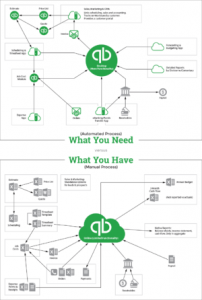Do you remember your first bicycle? Did it have one gear, and you had to quickly slam the pedals backward to brake? Do you remember begging for a new bicycle, probably a ten speed? And – this is the critical bit – did one of your parents tell you “The more gears it has, the more things can go wrong with it?” (One of our moms did.) When we grew up, this became “Keep It Simple”.
Truer words were never spoken: the chain can fall off the lower gear and get jammed, or the higher gear and into the spokes; the gear cables or the brake cables can snap; the brake shoes can wear down. Fixing a flat on the rear tire on a one-speed was dead easy, but even pulling the rear wheel off a ten-speed to be able to find the flat is time-consuming.
Process = Method * Tools.
Any Process is made up of a Method and some Tools. The more steps your Method has – or the more fiddly the steps are – the more things that can go wrong with it. The next time you process an invoice, write down the number of steps it takes. Be as specific as you can. The finished list will be a lot longer than you ever imagined, but the silver lining is that you now can look at steps you can eliminate.
Start with Effectiveness: are you doing any steps that are completely unnecessary? Are you as the owner signing EVERY cheque? Are you detecting errors (a pound of cure), or trying to prevent them (ounce of prevention)?
Move on to Efficiency. Are you re-keying data, instead of copying and pasting? Are you copying and pasting when the information could be generated automatically?
Remember that this is about the Method – the nature and number of steps taken. If you can improve the Tools at the same time (typically by automating), great, but the focus at first should be on the Method for several reasons.
- Automating an error-prone process will increase output – and the number of errors.
- Fewer steps mean fewer places where errors can creep in, and errors are expensive.
- The Method influences the Tools: if you decide that you need to switch your carpentry Method from nailing to screwing, you want to spend money on an electric screwdriver, not waste it on a nail gun.
Profit Breakthrough:
Keep It Simple. Look at your processes for Efficiency and Effectiveness. First, cut out the number of steps (the Method). A checklist is a great place to start. Next, consider automating what’s left (the Tools). Automating a mistake prone process only increases the number of errors.
Consider the 80-20 Rule. Automating the routine gives you more time to focus on the value-add.
Your new process should Do It Right The First Time; it will save you three times as much effort, to say nothing of the knock-on costs.
Approach the design and the implementation as a whole, but try to do both in bite-sized chunks.

